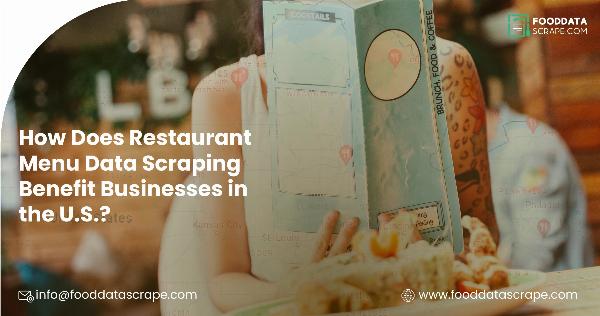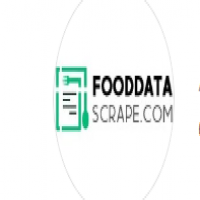How Does Restaurant Menu Data Scraping Benefit Businesses in the U.S.?

Strong 8k brings an ultra-HD IPTV experience to your living room and your pocket.
How-Does-Restaurant-Menu-Data-Scraping-Benefit-Businesses-in-the-U.S
Restaurant menu data scraping involves collecting menu data about restaurants from their websites and other online portals. It helps businesses gather robust and accurate information about menu items, including prices, descriptions, nutritional profiles, etc. Currently, in the U.S., menu data scraping is gaining popularity due to the possibility of obtaining helpful information for different parties.
Restaurant menu data scraping services assist in scrutinizing competitors' offerings, changing pricing models, and discovering new trends in the food industry. They also help in menu customization by identifying and adapting to customers' demands regarding available meals. Menu information is vital in preparing marketing and promotional strategies by marketing agencies.
As part of restaurant menu data scraping, food delivery platforms take the necessary measures to ensure that all the information displayed on the platform is relevant and accurate, thus improving user experience and order satisfaction. Scholars, analyzers, and researchers use menu data to analyze trends of culinary preference, nutritional patterns, and regional differences in eating behaviors.
In summary, this process is becoming more significant for the restaurant industry in the U.S., where various sectors enhance operational efficiency, innovation, and competitiveness.
Type of Information Collected from Scraping Restaurant and Menu Data
Type-of-Information-Collected-from-Scraping-Restaurant-and-Menu-Data
When collecting restaurant and menu data, the following types of information are typically collected:
Restaurant Name: Determines the source of menu data used in the establishment.
Menu Item Name: Used to assign a specific name or title to each item on the menu.
Menu Item Description: Can describe the ingredients used in preparing meals, how the meals are prepared, or other unique menu features.
Menu Item Price: Shows the food cost incurred for each dish on the menu with a view of enabling price comparison.
Category or Section: Identifies the menu part where each item (such as appetizers, entrées, or desserts) is located.
Availability: Indicates whether the menu item is available for order at the current time or periodically available during certain seasons.
Dietary Information: This section contains information on nutritional values, potential food allergens, and special dietary requirements for the menus offered.
Customer Ratings: Overall ratings or opinions given by the customers of each item on the menu.
Promotional Offers: Club discounts, promotions, and special offers that may be attached to food items on the menu.
Menu Changes: Record modifications made to menu items over time since they may experience seasonal or strategic alterations.
Why Do People Scrape Restaurant and Menu Data?
Why-Do-People-Scrape-Restaurant-and-Menu-Data
Conducting restaurant and menu data extraction serves as essential information for improving efficiency, customer satisfaction, and market competitiveness within the food service sector.
Strategic Decision-Making: Information obtained from restaurant menus enables firms to make the right decisions about menu changes, pricing strategies, and promotional activities. This will give restaurants a clear idea about how to customize their menus to provide clients with what they want while maximizing profits.
Personalized Customer Experiences: Restaurant menu data can enhance customers' experiences by providing specific recommendations or special offers based on their history of dining at this restaurant. This increases customer satisfaction and goodwill, resulting in repeated patronage and word-of-mouth referrals.
Menu Optimization and Engineering: By analyzing menu data, restaurants can improve their menus by identifying nonprofitable items, increasing their prices, and engineering the menu to peak at higher-margin items. This aids in generating more revenues per customer contact and also increases organizational productivity.
Market Insights and Expansion: Menu preferences and consumer behavior analysis can help restaurants find new locations for expansion across certain regions. Regional consumer preferences and trends should be considered, and the menu should be adjusted to appeal to the regional market.
Efficient Supply Chain Management: Scraping menu data helps manage the supply chain by offering data on ingredients, trends, and inventory levels. This assists in managing and reducing food wastage, cutting costs, and guaranteeing the regular supply of frequently ordered foods.
Brand Differentiation and Innovation: It also helps restaurants set their brand apart from competitors through creative menu displays, advertising unique dishes, and reacting effectively to food trends. This makes it easier for the restaurant to innovate and remain relevant in the current society where many restaurants exist.
How Can Business Benefits from Extracted Menu Data?
How-Can-Business-Benefits-from-Extracted-Menu-Data-01
Extracted menu data gives businesses insights into customer preferences, pricing strategies, and operational efficiency, driving growth and customer satisfaction.
Optimized Menu Planning: By analyzing the extracted menu data, it will be easy to know which menu items customers frequently order. This insight allows them to modify the menu so that customers can easily find what they want on the menu. This optimization also increases customers' satisfaction and profitability since it aims at products with higher sales potential.
Effective Pricing Strategies: Menu data scraping services are especially beneficial for businesses since they allow them to collect the necessary information on the market's pricing situation and competitors. With this information, they can price their products to help them cover costs and generate as much profit as possible. This involves offering prices relative to consumer evaluations and the cost of the various foods and beverages on the menu.
Enhanced Customer Insights: Additional menu data from Restaurant Menu Data Scraping provide corporate entities with insights into their customers' consumption trends, health concerns, and purchasing preferences. These insights enable targeted advertising and timely recommendations regarding the menu to customers to boost customer satisfaction. Businesses can use this information to prepare promotions, loyalty programs, and other models that can be adopted in the market.
Improved Operational Efficiency: Having timely and accurate menu information is beneficial to managing the supply chain more effectively. Restaurant Menu Data Scraping enhances demand forecast and inventory management in businesses, leading to a reduction in food wastage. This efficiency not only helps to reduce expenses but also guarantees that the frequently ordered meals are constantly available, thus increasing the stability of the service.
Competitive Advantage: This data aids businesses in understanding their competitors' menus and price trends to enable them to stay a step ahead. They can easily recognize new trends in the market, seize opportunities, and diversify their products to appeal to more consumers. It is also a proactive approach that ensures the organization remains competitive in the market and creates the necessary growth.
Innovative Menu Development: Market analysis results allow for creating new dishes or promoting limited-time offers based on what is currently popular. From the scraped customer feedback and performance data, businesses can fine-tune and adapt their menu options to accommodate changing preferences over time.
Customer Satisfaction: The incorporation of menu data to provide personalized dining experiences plays a significant role in enhancing customer satisfaction and loyalty. Consumers can get suggestions within interest areas, feature products that may catch their attention, and place orders without a hitch. Such a strategy contributes to customer loyalty and leads to positive word of mouth and reviews, improving business reputation and development.
Conclusion
Collecting menu items from restaurants in the U. S. using a restaurant data scraper is fundamental to achieving competitiveness in the constantly evolving foodservice market. It offers various benefits that may include consumer preferences, market trends, and efficiency in the operation of the business. In particular, data helps restaurants adjust their menus, fees, and promotions to meet customers' requirements and expectations. Also, it helps with strategic planning and management, improves customer experience, and encourages creativity in food services. In conclusion, as technology evolves, menu data will always be crucial in formulating strategies for growth, market competitiveness, and satisfying dining experiences across the United States.
Are you in need of high-class scraping services? Food Data Scrape should be your first point of call. We are undoubtedly the best in Food Data Aggregator and Restaurant Mobile App Scraping, and we render impeccable data analysis for strategic decision-making. With a legacy of excellence as our backbone, we help companies become data-driven, fueling their development. Please take advantage of our tailored solutions that will add value to your business. Contact us today to unlock the value of your data.
Read More>>https://www.fooddatascrape.com/restaurant-menu-data-scraping-benefit-businesses-in-the-us.php
#RestaurantMenuDataScrapingInTheUS
#ExtractRestaurantMenuDataInTheUS
#RestaurantMenuDataCollectionInTheUS
#ScrapeRestaurantMenuDataInTheUS
#RestaurantMenuDataScraperInTheUS
#RestaurantDataScrapingSolutions
Note: IndiBlogHub features both user-submitted and editorial content. We do not verify third-party contributions. Read our Disclaimer and Privacy Policyfor details.


